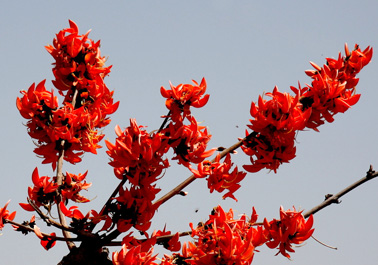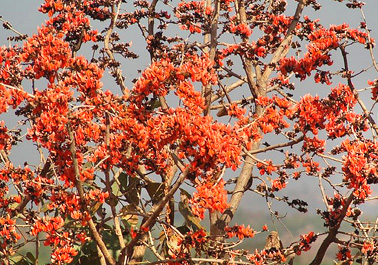|
Botanical Name:
Butea monosperma
Palasa consists of dried flower of Butea monosperma (Lam.)
Kuntze, (Synonym Butea frondosa Koeing ex Roxb), Family
Fabaceae
Common Name(s) in English & Indian Languages
Sanskrit: Kimsuka, Raktapuspaka, Ksarsrestha
Bengali: Palash
English: Bastard teak, Flame of the Forest,
Guajarati: Khaakharo
Hindi: Dhaak, Tesu, Palaash
Kannada: Muttug, Muttulu
Malayalam: Plashu
Marathi: Palas, Palash paapda
Oriya: Porasu, Kijuko
Punjabi: Tesh
Tamil: Purasu
Telugu: Moduga
Botanical description:
It is a small or moderate size deciduous tree with irregular
branches, exuding a red juice when cut. It have usually
crooked trunk, black nodose or thick branchlets, untidy in
growth & rugged in shape, bark fibrous & light brown or grey
in colour. Young shoot downy tomentose. The height of the
tree is about 10-15 m. leaves trifoliate, stipellate,
petiole 10-25cm long, stipules tomentose. Leaflets
coriaceous, rhomboid or broadly obovate from a connate base,
the lateral ovate or elliptic oblique, all obtuse, 10-20 cm
long, 15-20cm, broad, leathery, finely silky below when
young, truning glabrous with age, nerves conspicuous,
terminal glabrous with age, nerves conspicuous terminal
leaflets obovate, broad, hard, leaves falls off during
winter. Flowers large, scarlet & orange about 5 cm long on
racemes, upto 15 cm long. Pedicels brown, velvety, flowers
borne in great profusion on the usually leaflets the colour
of the flower may be yellow, orange, red, orange scarlet in
variety of shades branches. Calyx velvety, black,
componalate, coriaceous, calyx teeth short, the upper 2
connate, upper lip sub-emarginate, lower with three deltoid
teeth, calyx 1.2 cm long, silky white within. Petal colour
variable, standard flaming orange, outside grey-silky,
pubescent, lateral petals similar to the standar, but
narrower, the keel petals united to form a beak, wing
falcate. Stramen 10, diadelphous, 9 jointed & 1 free, ovary
stalked, 4 ovuled, style curved, stigma capitate, pods
profuse, ligulate, style curved, stigma capitate. Pods
profuse, ligulate, silky tomentose, 10-15 cm long, 2-4cm
broad, pendulous, strongly nerved, pale green, 1 seeded,
dehiscent upto the seed, curved with slivery hairs & give
impression of foliage, yellowish grey when ripe.
Parts used:
Flowers
Major chemical constituent:
Glycosides and Flavonoids
Therapeutic uses:
• Piles (Arsa)
• Burning sensation (Daha)
• Malabsorbtion syndrome (Grahni)
• Worm infestation (Krmi)
• Diseases of skin (Kustha)
• Excessive flow of urine (Meha)
• Dysuria (Mutrakrcchra)
• Bleeding disorder (Raktapitta)
• Disorders of blood (Raktavikara)
• Gout (Vatarakta)
• Cyst (Granthi)
• Splenic disease (Pliharoga)
• Itching (Kandu) |
|

 |
|
|



